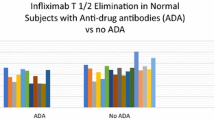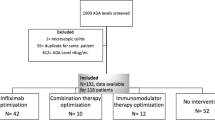Abstract
Introduction
The pharmacokinetic equivalence of dose intensification with adalimumab (ADA) 80 mg every other week (EOW) compared to weekly 40 mg has only been supported by modeling systems.
Aim of the Study
To compare the trough levels of ADA (TLA) and the occurrence of anti-ADA antibodies (AAA) between these two treatment regimens.
Patients and Methods
This was a prospective study including all consecutive patients with inflammatory bowel disease (IBD) who had reached a longstanding and deep remission under treatment with ADA 40 mg once a week. In these patients, the ADA regimen was changed from 40 mg/week to 80 mg EOW. TLA and AAA levels using a drug-tolerant assay were monitored before and ten weeks after from the change in the ADA regimen and the results compared by a Wilcoxon paired test.
Results
Sixty-two patients (60% CD, mean age 35 years) were included. Before and ten weeks after the changes of ADA regimen, the median TLA were (6.9 µg/mL versus 7.0 µg/mL, respectively; P = 0.34) and the AAA levels (3.4 µg/ml-eq versus 3.0 µg/ml-eq, respectively; P = 0.25.) were quite similar. Likewise, quartiles of TLA (Kendall test r = 0.91; P < 0.001) and AAA (r = 0.78; P < 0.001) did not differ before and after ADA regimen. When stratifying all the patients into 4 groups based on drug/antibody levels (immunogenic, subtherapeutic, therapeutic, or supratherapeutic), no patient needed for returning to the previous weekly regimen. In terms of acceptability, more than 60% of patients preferred an injection EOW compared once a week.
Conclusions
In IBD patients who achieved a deep clinical remission under ADA 40 mg once a week, the pharmacokinetic of ADA was similar when ADA regimen was changed to 80 mg EOW. Given the patient’s preference for the latter regimen, a modification of injection regimen should be systematically proposed.


Similar content being viewed by others
Abbreviations
- ADA:
-
adalimumab
- TLA:
-
trough levels of adalimumab
- AAA:
-
antibodies against adalimumab
- CD:
-
Crohn’s disease
- UC:
-
Ulcerative colitis
- TNF:
-
Tumor necrosis factor
- ELISA:
-
Enzyme-linked immunosorbent assay
- CRP:
-
C-reactive protein
- CDAI:
-
Crohn’s disease activity index
References
U.S. Food and Drug Administration [internet]. Humira. Highlights of prescribing information; 2017 [cited 2018 Nov 27]. https://www.accessdata.fda.gov/drugsatfda_docs/label/2008/125057s0110lbl.pdf.
European Medicines Agency [internet]. Humira. Summary of product characteristics; 2017 [cited 2018 Nov 27]. http://www.ema.europa.eu/docs/en_GB/document_library/EPAR__Product_Information/human/000481/WC500050870.pdf.
Kennedy NA, Heap GA, Green HD, et al. Predictors of anti-TNF treatment failure in anti-TNF-naive patients with active luminal Crohn’s disease: a prospective, multicentre, cohort study. Lancet Gastroenterol Hepatol. 2019;4:341–353.
Billioud V, Sandborn WJ, Peyrin-Biroulet L. Loss of response and need for adalimumab dose intensification in Crohn’s disease: a systematic review. Am J Gastroenterol. 2011;106:674–684.
Roblin X, Rinaudo M, Del Tedesco E, et al. Development of an algorithm incorporating pharmacokinetics of adalimumab in inflammatory bowel diseases. Am J Gastroenterol. 2014;109:1250–1256.
Baert F, Glorieus E, Reenaers C, et al. Adalimumab dose escalation and dose de-escalation success rate and predictors in a large national cohort of Crohn’s patients. J Crohns Colitis. 2013;7:154–160.
Ward MG, Warner B, Unsworth N, et al. Infliximab and adalimumab drug levels in Crohn’s disease: contrasting associations with disease activity and influencing factors. Aliment Pharmacol Ther. 2017;46:150–161.
Billioud V, Laharie D, Filippi J, et al. Adherence to adalimumab therapy in Crohn’s disease: a French multicenter experience. Inflamm Bowel Dis. 2011;17:152–159.
Rubin DT, Mittal M, Davis M, Johnson S, Chao J, Skup M. Impact of a patient support program on patient adherence to adalimumab and direct medical costs in Crohn’s Disease, ulcerative colitis, rheumatoid arthritis, psoriasis, psoriatic arthritis, and ankylosing spondylitis. J Manag Care Spec Pharm. 2017;23:859–867.
Ben-Horin S, Yavzori M, Katz L, et al. The immunogenic part of infliximab is the F(ab’)2, but measuring antibodies to the intact infliximab molecule is more clinically useful. Gut. 2011;60:41–48.
Colombel JF, Sandborn WJ, Rutgeerts P, et al. Adalimumab for maintenance of clinical response and remission in patients with Crohn’s disease: the CHARM trial. Gastroenterology. 2007;132:52–65.
Colombel JF, Sandborn WJ, Reinisch W, et al. Infliximab, azathioprine, or combination therapy for Crohn’s disease. N Engl J Med. 2010;362:1383–1395.
Ben-Horin S, Chowers Y, Ungar B, et al. Undetectable anti-TNF drug levels in patients with long-term remission predict successful drug withdrawal. Aliment Pharmacol Ther. 2015;42:356–364.
Little RD, Chu IE, van der Zanden EP, et al. Comparison of adalimumab serum drug levels when delivered by pen versus syringe in patients with inflammatory bowel disease An international, multicentre cohort analysis. J Crohns Colitis. 2019;13:1527–1536.
Author information
Authors and Affiliations
Corresponding author
Ethics declarations
Conflict of interest
All authors have declare that they have no conflict of interest.
Additional information
Publisher's Note
Springer Nature remains neutral with regard to jurisdictional claims in published maps and institutional affiliations.
Electronic supplementary material
Below is the link to the electronic supplementary material.
Rights and permissions
About this article
Cite this article
Paul, S., Williet, N., Nancey, S. et al. No Difference of Adalimumab Pharmacokinetics When Dosed at 40 mg Every Week or 80 mg Every Other Week in IBD Patients in Clinical Remission After Adalimumab Dose Intensification. Dig Dis Sci 66, 2744–2749 (2021). https://doi.org/10.1007/s10620-020-06567-x
Received:
Accepted:
Published:
Issue Date:
DOI: https://doi.org/10.1007/s10620-020-06567-x




